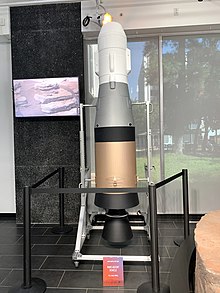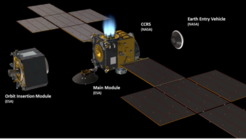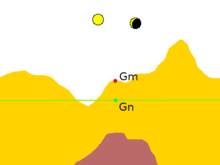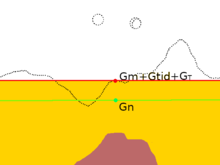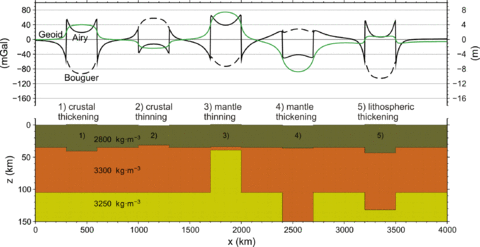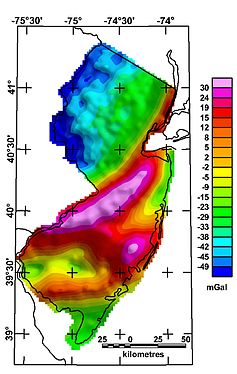A Mars sample-return (MSR) mission is a proposed mission to collect rock and dust samples on Mars and return them to Earth. Such a mission would allow more extensive analysis than that allowed by onboard sensors.
The three most recent concepts are a NASA–ESA proposal, a CNSA proposal, Tianwen-3, and a Roscosmos proposal, Mars-Grunt. Although NASA and ESA's plans to return the samples to Earth are still in the design stage as of 2022, samples have been gathered on Mars by the Perseverance rover.
Risks of cross-contamination of the Earth biosphere from returned Martian samples have been raised, though the risk of this occurring is considered to be extremely low.
Scientific value
Once returned to Earth, stored samples can be studied with the most sophisticated science instruments available. Thomas Zurbuchen, associate administrator for science at NASA Headquarters in Washington, expect such studies to allow several new discoveries at many fields. Samples may be reanalyzed in the future by instruments that do not yet exist.
In 2006, the Mars Exploration Program Analysis Group identified 55 important investigations related to Mars exploration. In 2008, they concluded that about half of the investigations "could be addressed to one degree or another by MSR", making MSR "the single mission that would make the most progress towards the entire list" of investigations. Moreover, it was reported that a significant fraction of the investigations could not be meaningfully advanced without returned samples.
One source of Mars samples is what are thought to be Martian meteorites, which are rocks ejected from Mars that made their way to Earth. As of April 2019, 266 meteorites had been identified as Martian, out of over 61,000 known meteorites. These meteorites are believed to be from Mars because their elemental and isotopic compositions are similar to rocks and atmospheric gases analyzed on Mars.
History
For at least three decades, scientists have advocated the return of geological samples from Mars. One early concept was the Sample Collection for Investigation of Mars (SCIM) proposal, which involved sending a spacecraft in a grazing pass through Mars's upper atmosphere to collect dust and air samples without landing or orbiting.
The Soviet Union considered a Mars sample-return mission, Mars 5NM, in 1975 but it was cancelled due to the repeated failures of the N1 rocket that would have launched it. Another sample-return mission, Mars 5M (Mars-79), planned for 1979, was cancelled due to complexity and technical problems.
The United States' Mars Exploration Program, formed after Mars Observer's failure in September 1993, supported a Mars sample return. One architecture was proposed by Glenn J. MacPherson in the early 2000s.
In 1996, the possibility of life on Mars was raised when apparent microfossils were thought to have been found in Mars meteorite, ALH84001. This hypothesis was eventually rejected, but led to a renewed interest in a Mars sample return.
As of late 1999, the MSR mission was anticipated to be launched from Earth in 2003 and 2005. Each was to deliver a rover and a Mars ascent vehicle, and a French supplied Mars orbiter with Earth return capability was to be included in 2005. Sample containers orbited by both MAVs were to reach Earth in 2008. This mission concept, considered by NASA's Mars Exploration Program to return samples by 2008, was cancelled following a program review.
In the summer of 2001, the Jet Propulsion Laboratory (JPL) requested mission concepts and proposals from industry-led teams (Boeing, Lockheed Martin, and TRW). The science requirements included at least 500 grams of samples, rover mobility to obtain samples at least 1 kilometer from the landing spot, and drilling to obtain one sample from a depth of 2 meters. That following winter, JPL made similar requests of certain university aerospace engineering departments (MIT and the University of Michigan).
Also in 2001, a separate set of industry studies was done for the Mars ascent vehicle (MAV) due to the uniqueness and key role of the MAV for MSR. Figure 11 in this reference summarized the need for MAV flight testing at a high altitude over Earth, based on Lockheed Martin's analysis that the risk of mission failure is "extremely high" if launch vehicle components are only tested separately.
In 2003, JPL reported that the mission concepts from 2001 had been deemed too costly, which led to the study of a more affordable plan accepted by two groups of scientists, a new MSR Science Steering Group and the Mars Exploration Program Analysis Group (MEPAG). Instead of a rover and deep drilling, a scoop on the lander would dig 20 centimeters deep and place multiple samples together into one container. After five years of technology development, the MAV would be flight-tested twice above Earth before the mission PDR (Preliminary Design Review) in 2009.
In mid-2006, the International Mars Architecture for the Return of Samples (iMARS) Working Group was chartered by the International Mars Exploration Working Group (IMEWG) to outline the scientific and engineering requirements of an internationally sponsored and executed Mars sample-return mission in the 2018–2023 time frame.
In October 2009, NASA and ESA established the Mars Exploration Joint Initiative to proceed with the ExoMars program, whose ultimate aim is "the return of samples from Mars in the 2020s". ExoMars's first mission was planned to launch in 2018 with unspecified missions to return samples in the 2020–2022 time frame. The cancellation of the caching rover MAX-C in 2011, and later NASA withdrawal from ExoMars, due to budget limitations, ended the mission. The pull-out was described as "traumatic" for the science community.
In early 2011, the US National Research Council's Planetary Science Decadal Survey, which laid out mission planning priorities for the period 2013–2022, declared an MSR campaign its highest priority Flagship Mission for that period. In particular, it endorsed the proposed Mars Astrobiology Explorer-Cacher (MAX-C) mission in a "descoped" (less ambitious) form. This mission plan was officially cancelled in April 2011.
In September 2012, NASA announced its intention to further study several strategies of bringing a sample of Mars to Earth – including a multiple launch scenario, a single-launch scenario, and a multiple-rover scenario – for a mission beginning as early as 2018. A "fetch rover" would retrieve the sample caches and deliver them to a Mars ascent vehicle (MAV). In July 2018, NASA contracted Airbus to produce a "fetch rover" concept.
In April 2018, a letter of intent was signed by NASA and ESA that may provide a basis for a Mars sample-return mission. In July 2019, a mission architecture was proposed. In April 2020, an updated version of the mission was presented.
A key mission requirement for the Mars 2020 Perseverance rover mission was that it help prepare for MSR. The rover landed on 18 February 2021 in Jezero Crater to collect samples and store them in 43 cylindrical tubes for later retrieval.
Mars 2020 mission
The Mars 2020 mission landed the Perseverance rover in Jezero crater in February 2021. It collected multiple samples and packed them into cylinders for later return. Jezero appears to be an ancient lakebed, suitable for ground sampling.
In the beginning of August 2021, Perseverance made its first attempt to collect a ground sample by drilling out a finger-size core of Martian rock. This attempt did not succeed. A drill hole was produced, as indicated by instrument readings, and documented by a photograph of the drill hole. However, the sample container turned out to be empty, indicating that the rock sampled was not robust enough to produce a solid core.
A second target rock judged to have a better chance to yield a sufficiently robust sample was sampled at the end of August and the beginning of September 2021. After abrading the rock, cleaning away dust by puffs of pressurized nitrogen, and inspecting the resulting rock surface, a hole was drilled on September 1. A rock sample appeared to be in the tube, but it was not immediately placed in a container. A new procedure of inspecting the tube optically was performed. On September 6, the process was completed and the first sample placed in a container.
The NASA-ESA plan is to return samples using three missions: a sample collection mission (Perseverance), a sample retrieval mission (Sample Retrieval Lander + Mars ascent vehicle + Sample Transfer arm + 2 Ingenuity class helicopters), and a return mission (Earth Return Orbiter). The mission hopes to resolve the question of whether Mars once harbored life.
Sample collection
The Mars 2020 mission landed the Perseverance rover, which is storing samples to be returned to Earth later. After consideration, it was decided that given Perseverance's expected longevity, it will be the primary means of transporting samples to Sample Retrieval Lander (SRL).
Sample retrieval
(Artwork; 27 July 2022)
The sample retrieval mission involves launching a sample return lander in 2028 with the Mars Ascent Vehicle and two Ingenuity class sample recovery helicopters, both of which will be collecting the samples with a tiny robotic arm as a backup for Perseverance. The rover and helicopters will transport the samples to the SRL lander. SRL's robotic arm will be used to extract the samples and load them into the Sample Return Capsule in the Ascent Vehicle. It is planned to land near the Octavia E. Butler Landing site in 2029.
Mars Ascent Vehicle (MAV)
MAV is a 3-meter long, two-stage, solid-fueled rocket that will deliver the collected samples from the surface of Mars to the Earth Return Orbiter. Early in 2022, Lockheed Martin was awarded a contract to partner with NASA's Marshall Space Flight Center in developing the MAV. It is planned to be catapulted into the air just before it ignites, at a rate of 16 feet (5 meters) per second, to remove the odds of wrong liftoff like slipping or tilting of SRL under rocket's shear weight and exhaust at liftoff. This Vertically Ejected Controlled Tip-off Release (VECTOR) system adds a slight rotation during launch, pitching the rocket up and away from the surface. MAV would enter a 380 km orbit. It will remain stowed inside a cylinder on the SRL and will have a thermal protective coating. The rocket's first stage would be run by a single updated STAR-20 engine burning for 70 seconds, while the second stage would have a single updated STAR-15 engine burning for another 27 seconds. They would be separated by a coast phase, after which the sample container would be released in orbit. As of early 2022, the second stage is planned to be spin-stabilized to save weight in lieu of active guidance, while the Mars samples will result in an unknown payload mass distribution.
MAV is scheduled to be launched in 2028 on board the SRL lander.
Sample return
Earth Return Orbiter (ERO)
ERO is an ESA-developed spacecraft. It includes the NASA-built Capture and Containment and Return System to rendezvous with the samples delivered by MAV in low Mars orbit (LMO).
ERO is scheduled to launch on an Ariane 64 rocket in 2027 and arrive at Mars in 2028, using ion propulsion and a separate propulsion element to gradually reach the proper orbit and then rendezvous with the orbiting sample. The MAV's 2nd stage will have a radio beacon that will give controllers the information they need to get the ESA Earth Return Orbiter close enough to the Orbiting Sample to see it through reflective light and capture it for return to earth. The orbiter will retrieve and seal the canisters in orbit and use a NASA-built robotic arm to place the sealed container into an Earth-entry capsule. It will raise its orbit, release the propulsion element, and return to Earth during the 2033 Mars-to-Earth transfer window.
Earth Entry Vehicle (EEV)
The Capture/Containment and Return System (CCRS) would stow the sample in the EEV. EEV would return to Earth and land passively, without a parachute. The desert sand at the Utah Test and Training Range and shock absorbing materials in the vehicle were planned to protect the samples from impact forces. EEV is scheduled to land on Earth in 2033.
Additional plans
China
China has announced plans for a Mars sample-return mission to be called Tianwen-3. The mission would launch in late 2028, with a lander and ascent vehicle on a Long March 5 and an orbiter and return module launched separately on a Long March 3B. Samples would be returned to Earth in July 2031.
A previous plan would have used a large spacecraft that could carry out all mission phases, including sample collection, ascent, orbital rendezvous, and return flight. This would have required the super-heavy-lift Long March 9 launch vehicle. Another plan involved using Tianwen-1 to cache the samples for retrieval.
France
France has worked towards a sample return for many years. This included concepts of an extraterrestrial sample curation facility for returned samples, and numerous proposals. They worked on the development of a Mars sample-return orbiter, which would capture and return the samples as part of a joint mission with other countries.
Japan
On 9 June 2015, the Japanese Aerospace Exploration Agency (JAXA) unveiled a plan named Martian Moons Exploration (MMX) to retrieve samples from Phobos or Deimos. Phobos's orbit is closer to Mars and its surface may have captured particles blasted from Mars. The launch from Earth is planned for September 2024, with a return to Earth in 2029. Japan has also shown interest in participating in an international Mars sample-return mission.
Russia
A Russian Mars sample-return mission concept is Mars-Grunt. It adopted Fobos-Grunt design heritage. 2011 plans envisioned a two-stage architecture with an orbiter and a lander (but no roving capability), with samples gathered from around the lander by a robotic arm.
Back contamination
Whether life forms exist on Mars is unresolved. Thus, MSR could potentially transfer viable organisms to Earth, resulting in back contamination — the introduction of extraterrestrial organisms into Earth's biosphere. The scientific consensus is that the potential for large-scale effects, either through pathogenesis or ecological disruption, is small. Returned samples would be treated as potentially biohazardous until scientists decide the samples are safe. The goal is that the probability of release of a Mars particle is less than one in a million.
The proposed NASA Mars sample-return mission will not be approved by NASA until the National Environmental Policy Act (NEPA) process has been completed. Furthermore, under the terms of Article VII of the Outer Space Treaty and other legal frameworks, were a release of organisms to occur, the releasing nation(s) would be liable for any resultant damages.
The sample-return mission would be tasked with preventing contact between the Martian environment and the exterior of the sample containers.
In order to eliminate the risk of parachute failure, the current plan is to use the thermal protection system to cushion the capsule upon impact (at terminal velocity). The sample container would be designed to withstand the force of impact. To receive the returned samples, NASA proposed a custom Biosafety Level 4 containment facility, the Mars Sample-Return Receiving facility (MSRRF).
Other scientists and engineers, notably Robert Zubrin of the Mars Society, argued in the Journal of Cosmology that contamination risk is functionally zero leaving little need to worry. They cite, among other things, lack of any known incident although trillions of kilograms of material have been exchanged between Mars and Earth via meteorite impacts.
The International Committee Against Mars Sample Return (ICAMSR) is an advocacy group led by Barry DiGregorio, that campaigns against a Mars sample-return mission. While ICAMSR acknowledges a low probability for biohazards, it considers the proposed containment measures to be unsafe. ICAMSR advocates more in situ studies on Mars, and preliminary biohazard testing at the International Space Station before the samples are brought to Earth. DiGregorio accepts the conspiracy theory of a NASA coverup regarding the discovery of microbial life by the 1976 Viking landers. DiGregorio also supports a view that several pathogens – such as common viruses – originate in space and probably caused some mass extinctions and pandemics. These claims connecting terrestrial disease and extraterrestrial pathogens have been rejected by the scientific community.








